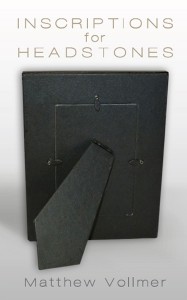~by Katherine D. Stutzman
148 pages/$12.00
“Here lies a man who….” Each of the thirty essays in Matthew Vollmer’s Inscriptions for Headstones begins with some variation on the traditional text of an epitaph. From there they spiral outward, memorializing experiences not often mentioned on gravestones: killing copperheads in the driveway with a shovel, tearing pages out of Playboy in a mall bookstore as a teenager, feeling guilty for spending time in front of the computer instead of taking your child sledding. Vollmer (Future Missionaries of America, Fakes) observes with pleasing precision the ordinary moments that make a life; he uses these moments to explore the relationship between memory and identity and to mourn the passing of the many different selves contained within each person’s history.
The essays in Inscriptions for Headstones are brief, usually no more than five or six pages, each written as a single sentence that wends circuitously through a mixture of reminiscence, digression, confession, and contemplation. The pieces all seem to be about the same man, referred to only as “the deceased,” captured at different points in his life from early childhood until he himself becomes the father of a young son. Certain motifs—an obsession with angels, a childhood in North Carolina, an adult life of teaching and writing—recur throughout the collection, binding the essays together and unifying their subject matter. Continue reading
![[PANK]](https://pankmagazine.com/wp-content/themes/pank/assets/images/pank-logo-large.png)

